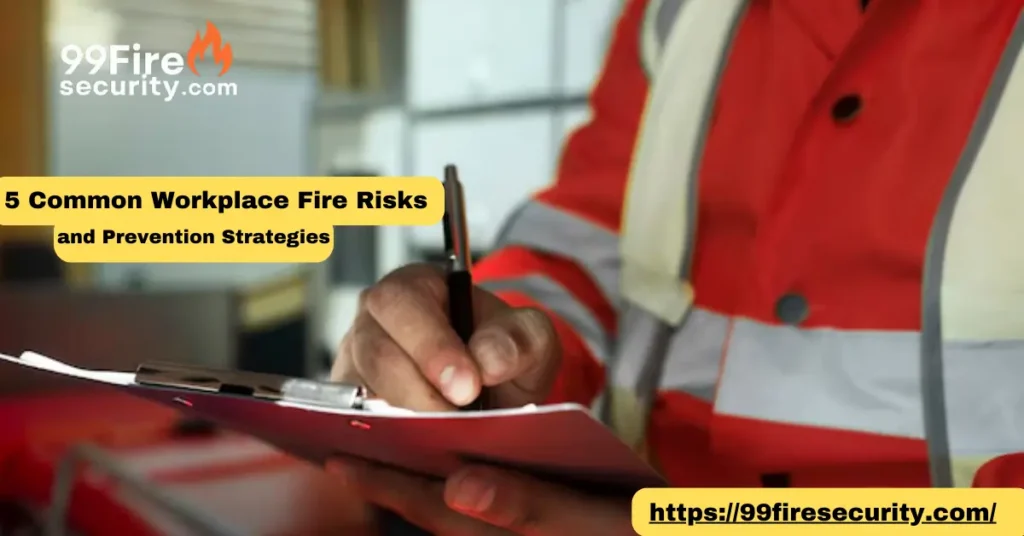Fires in the workplace top the list of worries for employers, workers and the general public. Thousands of fires occur at work every year, destroying property and livelihoods and taking lives. It is essential to prevent potential fire hazards from developing in the workplace.
In this article, we will walk you through the five most common workplace fire risks and useful firefighting tips to keep your office space free of fire hazards. But the bottom line is, if you know these risks, you can take the right steps to minimize them and provide better security and a safer workplace for everyone!
1. Electrical Hazards: Overloading and Faulty Wiring
Risk Overview
Fires caused by electricity are among the top three causes of workplace fires. These sorts of fires are usually the result of overloading power outlets, using faulty electric equipment, or poorly maintained wiring. In rare instances, having a device that was not properly installed or loose wires can cause a fire.
Prevention Strategies
- Frequent Inspections: A qualified electrician should inspect your building’s electrical system regularly, ensuring all wiring and equipment are in proper working condition.
- Avoid Overloading Circuits: Do not plug too many items into one circuit, and do not make permanent use of extension cords. Ensure that power strips have circuit breakers.
- Verify Equipment: All electrical devices and equipment must be compliant with safety standards. Replace equipment with faulty equipment immediately.
- Employee Awareness: Raise awareness among employees about taking care of the electrical equipment and be aware of potential hazards, like exposed wires or overheating devices.
2. Flammable Materials and Chemicals
Risk Overview
Many businesses have materials that can burn, such as chemicals, cleaning supplies, paper products and other combustible substances. These materials can easily set on fire, particularly in the presence of heat sources or open flames, if they are not properly stored or handled.
Prevention Strategies
Now, you should store flammable items in fireproof cupboards or containers. Keep liquids and chemical substances away from heat-producing devices.
- Identifying: Identify all burnable materials. Provide clear instructions on safe handling, storage and disposal.
- Ventilation: Ensure proper ventilation in chemical-use areas, and do not store large quantities of flammable substances in one spot.
- Disposal Procedures: Set procedures for disposing of flammable materials, including waste and chemicals. Dispose of hazardous materials according to local regulations.
3. Kitchen and Cooking Areas
Risk Overview
Most kitchen fires occur when cooking on breaks or at lunchtime. Many grease fires, overheated equipment, or unattended cooking appliances can blaze and spread across the building at lightning speed.
Prevention Strategies
- Supervised cooking: When using cooking appliances like stoves, microwaves, or toasters, ensure that employees are always present. Do not leave cooking appliances unattended.
- Routine Cleaning: Clean kitchen equipment on a routine basis, especially to remove grease deposits around cooking surfaces, stovetops, and ovens. Grease fires can form from buildup igniting from heat exposure.
- Fire Extinguishers: Ensure easily accessible grease and electrical fire-rated fire extinguishers in the kitchen area. Train employees on their effective use.
- Clear signage: Make sure you have clear fire safety signage in your kitchens, including what to do in the event of a kitchen fire (like covering a pan fire with a metal lid or using a fire blanket for grease fires).

4. Smoking and Open Flames
Risk Overview
Cigarettes also pose a serious fire risk, particularly in workplaces where highly combustible materials are stored nearby. And open flames like candles or space heaters can set things on fire if not handled correctly.
Prevention Strategies
- Areas for Smoking: Set up areas for smoking far from flammable materials, garbage canisters, and entrances. Hazards: Place cigarette butts and matches in safe disposal containers.
- No Fire: Ban candles, portable heaters or other open flames at work unless they are absolutely necessary and equipped with appropriate safety measures (such as automatic shut-offs).
- Enforcement of Smoke-Free Policy: Implement/wrap your guidelines with a strict smoke-free policy and regular checks to ensure that employees are following guidelines and using designated smoke-free areas.
- Routine Fire Drills: Implement routine fire drills to ensure that team members understand how to respond in the event of a fire caused by smoking or open flames.
5. Lack of Proper Fire Safety Equipment
Risk Overview
During a fire incident, inadequate or poorly maintained fire safety equipment can be disastrous. Emergency exits, sprinkler systems, smoke detectors, and fire extinguishers are among the key safety elements.
Prevention Strategies
- Wear Fire Retardant Clothing: Ensure you wear fire-retardant clothing at work. Test them once a month and change the batteries as needed.
- Emergency Exposure Routes: Ensure all emergency exit routes are kept clear and accessible. Install emergency lighting to help employees find their way to the exits during power outages.
- Regular Maintenance: Perform incremental fire safety audits to inspect the status and working condition of each piece of fire safety equipment. This involves inspecting fire extinguishers, sprinkler systems, and exit signs.

Conclusion
Fires in the workplace can easily be avoided if the necessary safety protocols are in place. By avoiding these five common fire risks and the prevention strategies in place, you can avoid a fire breaking out on your watch. Training, inspections, and maintenance should be regular to keep employees safe, protect your business, and prevent the impact of the damaging effects of a fire.
All of these fire prevention measures will keep your workplace safe, but they will also promote a safety culture and give your employees a sense of safety and security in their work environment. Only by doing this today can you prepare your workplace for fire and then guarantee a healthier environment.
FAQs
How frequently should fire safety equipment be inspected?
Fire safety equipment should be tested at a minimum once a year by a qualified technician. Fire extinguishers and smoke detectors, though, ought to be inspected monthly to ensure they are operating correctly.
Can chemicals be stored next to heat-generating appliances?
No, you should always store chemicals and flammable materials away from heat sources like your stove, your oven and electrical equipment to avoid starting a fire.
What to do if you find a workplace fire hazard
While each facility and department may have its own policies, generally you should immediately report any fire risk you discover to your supervisor or safety officer. Follow your workplace’s fire safety protocols, and make sure the full blight is handled as soon as possible.
Who can help me get rid of hazardous materials?
Dispose of in accordance with your local hazardous waste regulations. This most often takes the form of hazardous waste disposal programs in many communities, or your business may have some protocol for proper disposal.
How can I train employees to be fire-safe?
Share updated information regarding fire prevention and safety protocols as needed. Hold fire drills regularly to reinforce these practices.


